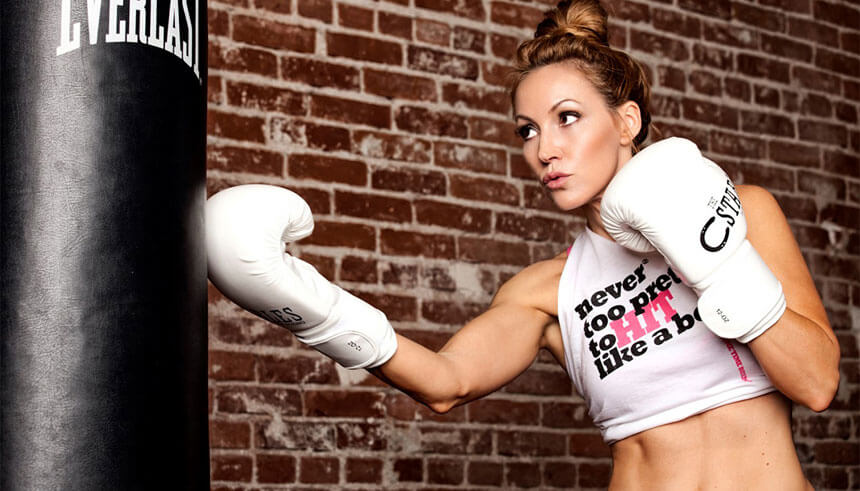Insights
Mind the Gender Gap: How Women Can Up Their Odds in the Business Arena
By Vickie An

Women entrepreneurs face more obstacles than their male counterparts when launching and growing their businesses. These resources can help.
Cary Williams has enjoyed her fair share of success as an entrepreneur. The former competitive boxer and Olympic-level boxing coach is the founder of two highly rated boxing clubs, the designer behind the empowering Too Pretty athleisure apparel line, and now, the CEO and co-creator of Boxing & Barbells, a new boxing and weightlifting training certification course. But, the California native will also tell you that not everyone was in her corner from the get-go.
Williams opened her first gym, Prime Time Boxing, in Sacramento, California, in 1998. At the time, she was a rookie business owner who had yet to become a fighter, and at 26, she was relatively young, too. But all that aside, there was one factor in particular that she felt gave people added pause about her ability to run a business—she’s a woman.
“I think it still happens, but 20 years ago, I think it was worse,” recalls Williams of the bias she encountered when trying to get her business off the ground. She still remembers the frustration she felt while searching for a gym space. “Most of the real estate brokers were men,” she says. “Some of them wouldn't give me the time of day. Some of them would show me around, but then scoff at a remark I would make or a question I had. They made me feel really uncomfortable, and it was like they were trying to make me feel incapable.”
The great gender divide
Williams is neither the first nor the last woman entrepreneur who has felt this way. In 2018, the National Women’s Business Council (NWBC) released an analysis of various studies conducted over the years that confirms what she sensed back then—that women business owners are often “tied to an unconscious association with less credibility and a lack of legitimacy.”
In other words, running a business is challenging, but running a business as a woman? It can be even harder. Unfortunately, gender bias favoring men is just one of many systemic obstacles that can prevent female founders from attaining their full potential—another is unequal access to financial capital.
Considering that more women than ever are taking the entrepreneurial leap, this is a big problem. Data from the 2018 State of Women-Owned Businesses report found that the number of women-owned firms has soared more than thirty-fold, from 402,000 in 1972 to 12.3 million in 2018. Last year, these businesses also employed more than 9 million people and generated an estimated $1.8 trillion in revenue. While women-led businesses still lag behind their male counterparts in revenue and employment, the numbers nevertheless illustrate the substantial contributions women entrepreneurs are making—and will continue to make—to the economy. Yet, underfunding remains one of the biggest challenges and impediments to growth for many women-led ventures.
All businesses—regardless of type, size or owner—need sufficient capital not only to survive, but to thrive. However, according to the NWBC, men are more likely to launch their businesses with nearly twice the capital as women, securing an average of $135,000 compared to $75,000. The disparity grows even larger when looking at men versus women-led firms with a high potential for growth.
What’s the deal?
The funding gap exists for a variety of reasons. The 2018 NWBC study found that gender bias can play a significant role in investor behavior, such as in the line of questioning venture capitalists (both men and women) pose to male and female entrepreneurs. For instance, one review found that male entrepreneurs are more likely to be asked questions about potential for gains. Women, on the other hand, get asked more about potential for losses.
So, it comes as no surprise that women founders have historically received venture funding at much lower rates than men, and when they do receive funding, it’s usually a fraction of what male founders get. To put that in perspective, Fortune reports that just 2.2 percent of all venture funds in 2017—or $1.9 billion of the $85 billion total invested by venture capitalists—went to teams comprised of all-women founders. All-male teams, on the other hand, grabbed an estimated $66.9 billion of the money pot, or about 79 percent.
It’s worth noting, though, that men are more likely to seek financing over the life of their business than women (34 percent of men compared to 25 percent of women, according to a recent SCORE report). Women who are seeking financing also tend to ask for about $35,000 less than male business owners. But again, of those who seek financing, men are more likely to get those loans or equity financing than women (38 percent versus 31 percent).
Why the hesitation to find external sources of financing? One study cited in the NWBC report points to the differences in motivations between men and women business owners: Men are “more likely to be motivated by firm growth and profits, while women were more motivated by personal fulfillment, flexibility or a sense of control over their destiny.” The authors suggest that it is this desire for autonomy that can make women business owners more risk-averse, because by seeking outside financing they will be forfeiting a degree of control.
Many women business owners do tend to be more cautious in how they approach growth, says Tim Jeffcoat, district director of the U.S. Small Business Association’s Houston District Office. Oftentimes, this reluctance to take greater risks leads women business owners to keep their ventures at smaller, more manageable sizes, he says. Men, on the other hand, tend to think on a larger scale. And because they’re focused on making their business “the biggest it can be,” they’re willing to take on more risks—and more debt—to do so.
What then ends up happening during the funding pitch, says Jeffcoat, is “the male business owner paints a picture of this wonderful growth opportunity, whereas the typical woman-owned business will go in and have much smaller growth plans and a much more conservative approach.” And that can make the chance of success look less realistic to a bank or to investors.
[Also read: SBA Loans 101: Frequently Asked Questions]
“My advice to any woman-owned business is when you go to see a banker, you need to have your A game. You need to be optimistic. You need to be prepared to be less risk-oriented,” Jeffcoat says. “This doesn't mean you have to go take a whole bunch of risks, but there is a way to do this to make sure you get funded.”
Fortunately, as research continues to shed light on the problem, and as the demand for equal access to funding gets louder, more resources are being made available to women entrepreneurs to help guide them.
SBA resources for women in business
The U.S. Small Business Administration (SBA) offers a slew of resources for women entrepreneurs via their district offices and through affiliates such as the Small Business Development Center, the Women’s Business Center and SCORE, a volunteer organization that provides mentorship to entrepreneurs.

Tim Jeffcoat stresses that the most important thing is not to worry about which SBA loan to apply for, but to get connected with a bank that can understand your needs, whether you need a line of credit, a short-term loan or a special loan with fixed interest rates.
And while the agency’s government loan programs aren’t strictly for women, they can be good sources of debt capital for business owners who can qualify. The loans are issued by participating lenders, such as banks, and are guaranteed by the government, so it becomes less risky for the bank.
In fiscal year 2018, the SBA guaranteed more than $30 billion to small businesses. Women business owners are certainly benefiting, receiving 30 percent, or $7.6 billion, of the SBA’s flagship 7(a) loans that were approved last year. The 7(a) loan program guarantees loans to small businesses of up to $5 million and are commonly used for purchasing land or equipment, and as working capital.
Last year also saw significant growth in the SBA’s Microloan and Community Advantage Programs. More than 5,000 loans totaling over $72 million were lent in the Microloan program, while some 1,000 loans totaling over $150 million were approved in the Community Advantage program. Women in business tend to favor microloans when it comes to kickstarting their businesses, due to the smaller dollar amount, predictable repayment terms and relatively low interest rates.
All said, Jeffcoat stresses that the most important thing is not to worry about which SBA loan to apply for, but to get connected with a bank that can understand your needs, whether you need a line of credit, a short-term loan or a special loan with fixed interest rates. “They’ll figure out which product makes the most sense,” he says.
Lydia Fong, an SBA relationship manager for East West Bank, agrees. She notes that the SBA loan program, with its favorable terms and lower interest rates, can be particularly useful for business owners who are looking for ways to finance real estate purchases, expand operations, buy equipment, and more. “[If a customer] needs financing from the bank, we will find a product that fits,” Fong says.
She adds that under the right conditions, even startups can get approved for an SBA loan, as long as they have good credit history, can prove experience in the industry, and have a secondary source of income to help repay the loan.
Knocking out the naysayers
An SBA loan is what allowed Cary Williams to open up her first boxing gym in Sacramento. Despite the setbacks she faced at the start, Williams felt confident about her vision: creating a boxing club for people who just wanted to learn the sport and get a good workout while doing it—a rare concept back in the day. “Pretty much, if you weren't a fighter, you weren't allowed to step into a boxing gym,” she explains.
Determined, she found another real estate broker—a woman—who helped her find the perfect location for the gym, and she enlisted a boxer friend to be the head trainer. When it came to procuring funds to get the venture going, she drafted a solid business plan and nailed her pitch to the bank, securing a $40,000 SBA loan.
“[The banker] listened to everything I had to say, and he said, ‘You know what? I'm going to give you a feel-good loan—I feel really good about what you're going to be doing. I feel good about your success and that you'd pay me back,’” Williams recounts. She used the money to put a deposit down on the lease, make improvements to the space and buy equipment. The rest is history.
About six years ago, Williams opened another gym under the Prime Time Boxing brand called The Stables, in Santa Monica, and the success she’s found so far has proven those original detractors wrong. But these days she views being a woman as an advantage in business rather than a challenge. “I think people underestimate me, which sometimes can give you the edge,” she says. “I have learned to not take things personally and just use it as something that empowers me and puts fuel on my fire.”
Learn more about how SBA loans can help your business grow
